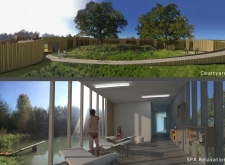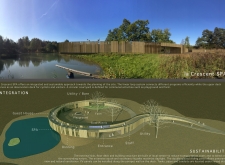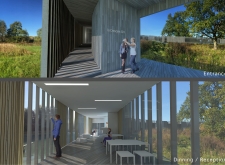5 key facts about this project
At its core, this project represents a modern interpretation of community-oriented architecture. By prioritizing open spaces and light-filled interiors, the design encourages interaction and collaboration, illustrating a thoughtful approach to how spaces can be used. The layout is organized to maximize the flow and accessibility for all users, with a clear demarcation of public and private areas promoting both community gathering and individual retreat. Key functional spaces are strategically placed to ensure that they benefit from natural light and views of the surrounding landscape, enhancing the overall user experience.
The choice of materials is integral to the project’s identity. By combining reinforced concrete for structural elements with warm timber finishes, the design reflects a commitment to sustainability while maintaining visual appeal. Large expanses of glass not only serve to connect the interior environment with the exterior but also contribute to energy efficiency by maximizing passive solar heating. The exterior is clad in locally sourced brick, which not only enhances thermal performance but also ensures that the building resonates with the architectural vernacular of the region.
Distinctive design approaches are evident throughout the project. The strategic use of overhangs and shading devices minimizes solar gain while allowing natural light to permeate the space. This thoughtful consideration of climate not only reflects best practices in sustainable architecture but also enhances the comfort of its occupants. The integration of green roof systems contributes to biodiversity, manages stormwater, and serves as an additional amenity for users.
Landscaping around the building has been meticulously planned to enhance the ecological footprint, featuring native plants that require minimal irrigation while promoting habitat establishment. This design element underlines the project’s commitment to sustainability and integrates it seamlessly into the landscape, creating a visually cohesive environment that encourages outdoor activities and engagement with nature.
The essence of the project is further enriched by its attention to detail. Interior spaces boast a variety of textures and finishes, from the warmth of wood to the coolness of stone. Each material was selected not only for its functional qualities but also for its contribution to an overall ambiance that fosters comfort and inspiration. Artful lighting installations underscore architectural features and enhance mood, while acoustical considerations ensure that spaces remain serene, conducive to both collaboration and reflection.
In summary, this architectural project exemplifies a well-considered response to the needs of its community and environment. By embracing sustainable practices and innovative design strategies, it manages to create a space that serves not only as a functional structure but also as a catalyst for social interaction and community development.
For those interested in delving deeper into the intricacies of this architectural endeavor, exploring the architectural plans, sections, designs, and ideas will provide valuable insights into how this project was conceived and realized. This exploration will reveal the thoughtful craftsmanship and design intentions that underpin the narrative of this significant architectural contribution.


























